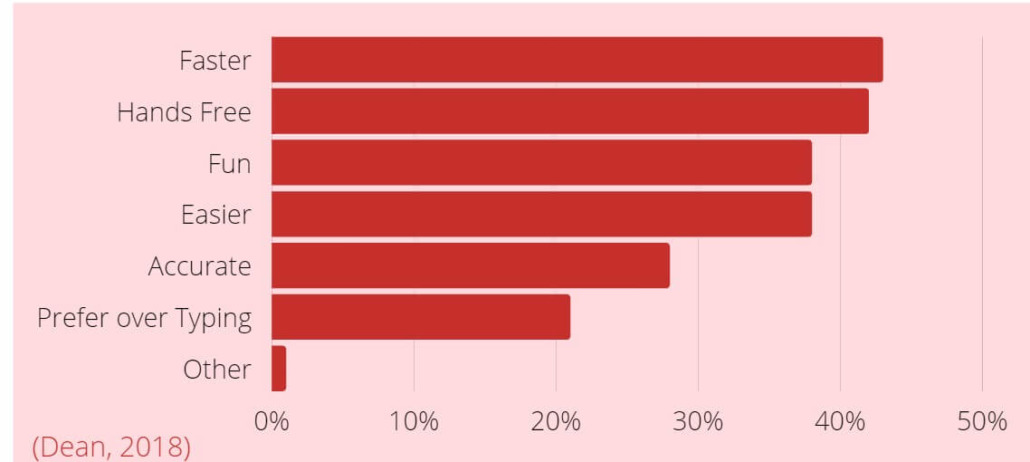How to Improve Your Voice SEO
Ok Google, why isn’t my website getting traffic?
Read on to find out how to improve your Voice SEO in 4 steps.
WHAT IS VOICE SEO?
Voice SEO involves optimising your site with keywords and keywords phrases directed towards conversational dialogue. It targets high-quality, informative, and accessible content to drive traffic to websites and to be the first choice for virtual assistants such as Amazon’s Alexa, Google Assistant, and Apple’s Siri.
High optimisation leads to improved experience, higher brand awareness, website traffic, and sales.
As voice search’s increase in popularity, it is important that your website is tailored to both the way we speak and type.

55% of Teens use voice search more than once a day and 41% of Adults use voice search more than once a day
70% of voice searches use natural and conversational language.
Essential: 65% of Google home and Amazon Echo owners say voice search is essential to their lives.
4 Key functions of Voice Search:
- Personal Assistant: Completing basic tasks such as creating a shopping list, timer,
playing music - Local Information: Listing local venues and businesses nearby, landmarks and things to do
- General Information: Giving factual information, instructions.
- Entertainment: Finding local events, booking tickets
Did you know: You could be missing out on hundreds of clicks and sales just by not being voice search friendly?
The popularity of voice assistants is changing the way people are using search engines today. With the arrival of smart homes, smart phones, watches, and cars, it is becoming even more readily available.
The subtle but important differences between Voice SEO and normal SEO is a chance to get ahead and gain a competitive edge. This blog will tell you exactly how to improve your Voice SEO ranking and make your way up the Search Engine Results Page (SERP’s).
FOUR WAYS TO IMPROVE YOUR VOICE SEO
1. Longtailed Key Words
Voice SEO vs SEO
A key difference between typed search and voice search is that typed searches are often short handed and therefore, regular SEO focuses on short-tailed keywords. Alternatively, voice searches involve extended dialogue and therefore voice SEO targets long-tailed keywords. Websites that are suited to both long-tail and short-tail keywords will have an advantage over those that do not.
Long tailed keywords have lower traffic than short tailed but have a higher conversion rate as they are more targeted searches and consumers are often further down the buyer decision journey! This is why long tailed keywords are crucial.
Example: Define Voice SEO VS ‘Ok Google, why is Voice SEO important for my business.’
2013 Hummingbird Update:
Search engines will use the user’s location and other personal data to provide relevant results and rich snippets.
With the 2013 Hummingbird update, Google changed how its search engine works. The new approaches focus more on natural language searches and often take context and meaning into account rather than just individual keywords. This means if you want to make your structured data and code easier for search engines to understand, you should use semantic vocabulary.
Quick Tip: Avoid jargon and use plain English to reach the broadest audience on your website
2. Near Me: My Business Listing
Boosting Local Traffic: A simple way to improve the visibility of your business right now would be to update (or create!) your business listing on Google. If you are a brick and mortar, it is especially important that you include locational tags such as the phrase “near me” and identify landmarks and localities to your listing. This will help your site include relevant content and appear locally for searchers.

Google trends reflects an upward trend over the past 5 years for ‘near me’ searches.
HOW TO MANAGE BUSINESS LISTINGS
- Create or use your existing Business to find you business here.
- Follow the steps by inputting accurate information about your business until your business listing is made. A video tutorial from Rank academy may also be helpful.
More is More: 58% of voice search users look for local business information, so adding accurate information about your business is essential.
Examples: Updated contact details, business locations, website details, trading hours, images, what your business does and who it is targeted towards.
My Business Listing Tips:
- Name:Use your Businesses real name. Including trading hours or location within your name will not help your listing, in fact it goes against Googles Policies.
- Best user experience: Make sure information is up to date: Utilise special trading hours if they differ on holidays
- Real content: Use real images from your business: Users and Search engines prefer this over stock images.
3. Mobile Friendly Page speeds
Why is Voice Search popular?

According to Google, 27% of all mobile searches are done by voice.
Mobile phones are users’ go-to source for quick, hands-free assistance, making voice search an effective and convenient tool. In addition to regular SEO, the nature of mobile phones is that we are constantly on the go. Therefore, voice commands have become more effective than ever before. In 2020, 68% of online searches were made on mobile, making mobile friendly optimisation crucial.
Page speed is a key element in mobile SEO, especially in voice searches, which demand fast, real-time responses. In addition to user expectations, search engines also value speed. Your website will be abandoned by the search engine if it takes too long to load, and it will move on to another site instead, directly impacting the bounce rate of your page.
Bounce Rate: Percentage of people who visit and then leave your site after visiting only one page. A lower bounce rate is ideal.
Test your Website
Google Page Speed speed test
Mobile compatibility test: Google mobile test
4. Question and Filler Keywords
Focusing on question key words is a simple way to improve Voice SEO and attract traffic to your website. The conversational nature of voice search means that people will ask full questions and expect prompt and concise responses. A FAQs page is an effective way of answering relevant questions about your product, service, and company that your target audience might have, directing search engines towards your website.
The use of question words such as Who, What, When, Where, Why, and filler words such as ‘the’, ‘to’, and ‘for’ are important in achieving similarities in human dialogue. Each year the number of Voice search using question words increases. The most popular question words are Who, How and When.
Quick Tip: The structure of your FAQs page should begin with the question using specific keywords, followed by a concise, informative answer.
Voice searches are on the rise and are a must have for the future of digital marketing. These are just 4 key tips to help you get your website Voice SEO.

Mayumi d'Aunou
Mayumi d'Aunou is a recent Commerce graduate from the University of Melbourne. With a background in Marketing and Economics, she is able to explain complex topics in the simplest of ways. You can find her on Linkedin.







